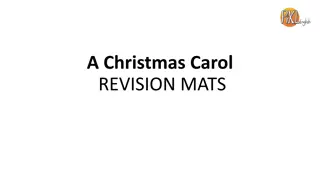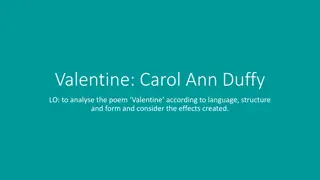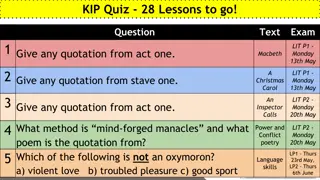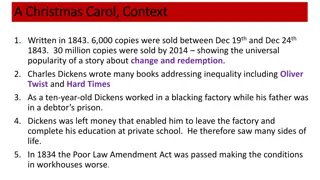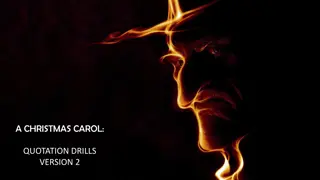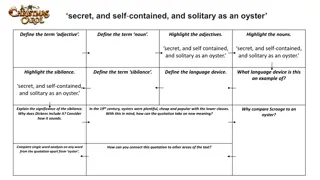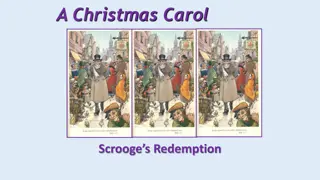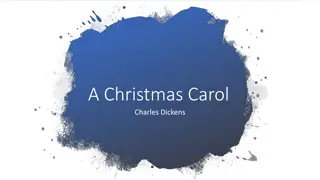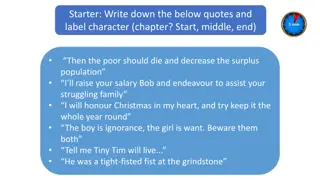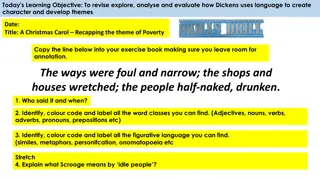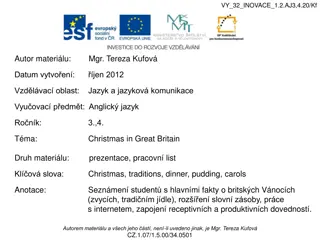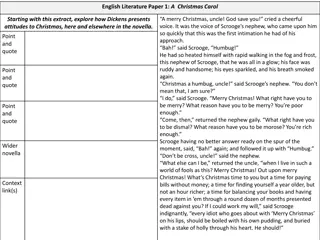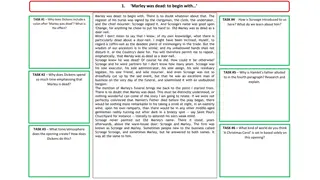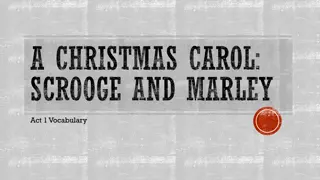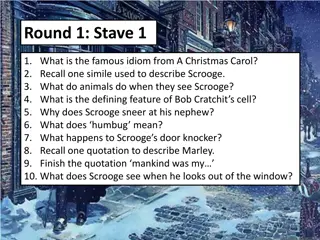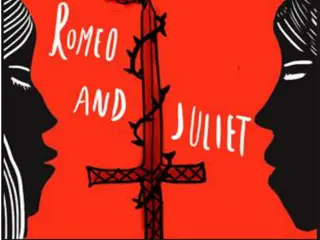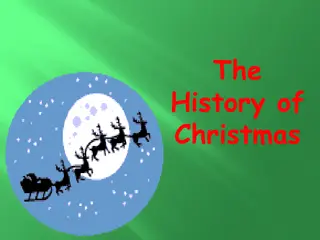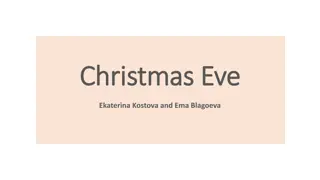Understanding the Form, Structure, and Language of "A Christmas Carol
Dickens' "A Christmas Carol" is a novella, blending a ghost story with a moral tale of redemption. The unique form, divided into five staves, mirrors a musical composition, while the three ghosts symbolize past, present, and future. The narrative's structure is akin to carols, presenting a transformative journey for the protagonist, Scrooge.
Download Presentation

Please find below an Image/Link to download the presentation.
The content on the website is provided AS IS for your information and personal use only. It may not be sold, licensed, or shared on other websites without obtaining consent from the author. Download presentation by click this link. If you encounter any issues during the download, it is possible that the publisher has removed the file from their server.
E N D
Presentation Transcript
A CHRISTMAS CAROL - REVISION FORM/STRUCTURE/ LANGAUGE
WALT To revise the FORM/STRUCTURE/LANGAUGE of the novella.
WHAT IS THE FORM? Dickens wrote A Christmas Carol in the form of: a novella a ghost story The tale is written as a novella. This is a short piece of fiction - longer than a short story, but shorter than a novel. Dickens published A Christmas Carol on 19th December 1843. It was traditional for ghost stories to be read at Christmas time, and this short novella form meant that the whole tale could be read aloud in one sitting
WHY THESE FORMS? Ghost story? Novella?
WHY THESE FORMS? Ghost story Dickens's novella features four ghosts in total: Jacob Marley and the three Ghosts of Christmas. He combines the tradition of reading ghost stories with a moral tale of redemption. Dickens used the form to appeal to the spirit of Christmas and to share a story that was so popular that the first print run of 6000 copies sold out by Christmas Eve in 1843! Novella The short novella form means the story can be read aloud in a short space of time, making it the ideal Christmas entertainment.
WHAT IS THE STRUCTURE? The novella is set out in five Staves. This is an unusual structure that mimics the way a musical piece is put together. The Staves follow the action of the story with the first stave setting the scene, the middle stave showing the turning point for Scrooge and the final stave concluding the story by presenting him as a changed man.
WHY THIS STRUCTURE? Carols and the five staves Three ghosts
WHY THIS STRUCTURE? Carols and the five staves Carols are songs that are popular at Christmas time and usually deal with stories of Christ's birth or with themes associated with the festive season. Some carols focus on joy and the spirit of giving to others. The structure of Dickens's novella uses a similar structure to a song to present a moral tale of transformation. Three ghosts The structure of the three ghosts showing the past, present and future appeals to readers on many levels. The number three is significant in fairy stories, religious tales and in traditional myths and legends. Characters are often faced with three choices, granted three wishes, or given three opportunities to change. Scrooge is shown his past, the present and a possible future and then finally finds the willingness to transform.
WHY THIS STRUCTURE? How important is the overall structure of this novella? the structure links to the theme of Christmas by reflecting the shape of a typical carol it has a clear beginning, middle and end through which we see a character's transformation the structure of three ghosts, showing the past, present and future, appeals to readers Scrooge's redemption in the final stave leaves the reader with a sense of both completion and possibility
WHAT ABOUT THE LANGUAGE? Dickens uses language to draw us into the story and to present characters and scenes that are entertaining. He uses a strong narrative voice that comments on the characters at the same time as telling their story. The narrator, though unnamed, has opinions about Scrooge and his tale. He also places himself and the reader at the heart of the action, by suggesting that he is 'standing in the spirit at (the reader's) elbow.' Dickens's language is highly descriptive and creates a vivid sense of place and setting.
REMEMBER When analysing the language Dickens has used, aim to: examine words and phrases think about the sorts of words he chose (positive, negative, descriptive) explore layers of meaning (what else could a phrase refer to or suggest?) notice any literary techniques (simile, metaphor, alliteration) explain the effects of the language used - how does it make you feel?
5 TYPES OF LANGUAGE USE NARRATIVE VOICE SIMILE DIALOGUE METAPHOR PERSONIFICATION
MORE DETAILS LANGUAGE USE Here s a BASIC example for LANGUAGE USE. Point Evidence Analysis and Language/Technical Term When Dickens first presents Scrooge he describes him as 'Hard and sharp as flint'. The simile likens the character to something that the reader can recognise. We see that Scrooge is tough and unbreakable Simile
LANGUAGE QUOTATION ANALYSIS Alleys and archways, like so many cesspools, disgorged their offences of smell, and dirt, and life, upon the straggling streets; and the whole quarter reeked with crime, with filth, and misery. How does the language in this quotation create a sense of place?
LANGUAGE QUOTATION ANALYSIS 'Alleys and archways' - alliteration creates a sense of a warren of small streets and tight spaces 'like so many cesspools' - this simile compares the streets to sewers and shows how disgusting they are 'straggling streets' - the adjective 'straggling' makes the streets seem winding and unruly 'reeked' - this verb is vivid and gives us a sense of a foul smell 'crime, with filth, and misery' - the list of three shows how dirty and dangerous the street are
PLENARY TEST! http://www.bbc.co.uk/education/guides/zwkdwmn/test


